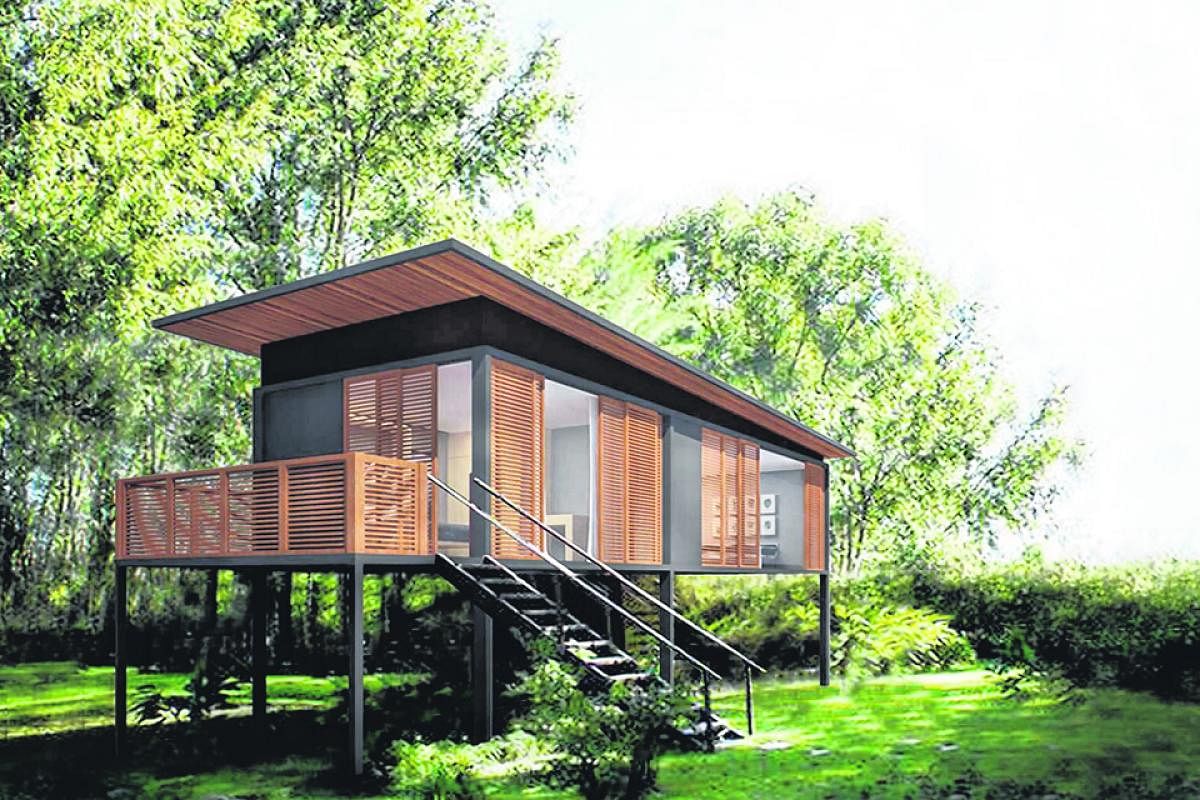Singapore-based companies are going big on tiny houses
Singapore-based companies, including Big Tiny and Pod Structures, are jumping on the bandwagon of making and selling small houses with eco-friendly features






In crowded cities where space is a premium, shoebox apartments are a reality for many people. But what about going further and living in a house that is barely larger than the size of a bedroom?
Call it the humblest of abodes. Dramatic downsizing of one's home has become a phenomenon in recent years, spreading first from the United States, after the subprime mortgage crisis, to the rest of the world.
Called the "tiny house" movement, the trend is to live in houses no larger than 400 sq ft or about the size of the master bedroom of a Housing Board flat.
Some people started building these miniature houses themselves, customising them to their own preferences.
But then businesses started to catch on to the demand and began specialising in making these homes as prefabricated units, from practical micro-homes in dense city areas to eco-friendly cabins in far-flung, off-the-grid places.
In recent months, a few Singapore-based companies have been getting in on the act.
One of them is Big Tiny, founded by three Singaporean entrepreneurs in March last year. It sells eco-friendly houses on wheels in scenic locations in Australia for $80,000 a pop.
When the owners are not staying in them, Big Tiny will help rent out the houses for between $150 and $250 a night. The properties will be listed on online accommodation booking sites Airbnb and Booking.com.
They are parked on land owned by farmers or vineyard owners, who get a slice of the rental profits. The landlords also meet guests when they arrive and help them settle in.
The houses' floor areas range from 161 sq ft - which can comfortably house two people - to 240 sq ft, which houses four people. The latter comes with a loft bedroom.
The prefabricated houses are assembled using machinery and can be yoked to a four-wheel-drive and transported to various locations.
Each house comes with solar panels, a rainwater collection system and a composting toilet. Nearly 30 people have bought these houses.
Big Tiny co-founder Adrian Chia, 37, says: "People are downsizing their houses to simplify their lives. In Big Tiny, we pair tiny houses with a spectacular rural setting."
Mr Chia, a former government scholar with the Singapore Land Authority, is also the founder of a systems and tech company.
The first two houses have been launched in New South Wales - on the edge of the Blue Mountains - and in Victoria. Five more are in the pipeline and Big Tiny will expand to Brisbane and New Zealand by the end of the year.
Big Tiny hopes to build these homes in Singapore. It wants to approach the Urban Redevelopment Authority to discuss the possibility of parking Big Tiny homes in scenic spots such as East Coast Park and Marina Barrage.
Another Singapore-based firm squeezing into the tiny house market is multi-disciplinary company Pod Structures, which was founded in 2015 and specialises in modular construction and Prefabricated Prefinished Volumetric Construction - a building method where large modules complete with finishes are manufactured in factories and assembled on-site.
The company's previous projects include hospital wards and pop-up stores.
It has designed 194 sq ft prefabricated housing units made from aluminium, composite material, cross-laminated timber and lightweight concrete panels.
One unit costs between US$20,000 (S$26,255) and US$30,000, excluding shipping.
Interior furnishings are basic, but buyers can opt for various eco-friendly features such as solar panels.
The firm has been in talks with a resort developer in Indonesia for the units to be placed in a scenic coastal area.
Chief executive Samuel Vedanaigam, 58, who is open to the idea of creating these tiny units for individual home owners as well, says: "In Singapore, there are all sorts of regulations. I think the market is overseas."
Meanwhile, Singapore-based multi-disciplinary design firm WY-TO - whose previous projects range from cultural buildings to shelters in disaster zones - is in the early stages of talks with a resort developer in Hainan, China. They are discussing the option of introducing housing "capsules" in Hainan next year.
Each capsule would be about 215 sq ft in size. It would come with a solar panel roof, rainwater collection system and vertical garden. Every pod will also be covered with a "smart skin" of photovoltaic algae that helps to generate energy.
A unit could cost about $50,000 to manufacture, says Mr Yann Follain, who founded the company in 2010 and is its managing director and head of design.
For those who can afford a second holiday home, compact houses may be a neat and efficient option. But are they good investments?
Real estate agency Chris International's director Chris Koh says it is a viable one since "the risk and the price are lower than buying expensive real estate".
Investing in small houses probably appeals more to young Singaporeans or those with a tighter budget, he says. But the concept is unlikely to take off in Singapore, he adds. "We're talking about high land costs."
Besides making financial sense, small homes also make environmental sense - well, mostly.
Assistant Professor Oliver Heckmann at the Singapore University of Technology and Design's faculty of Architecture and Sustainable Design says the tiny house model is eco-friendly insofar as it is compact because occupants are unlikely to consume as much resources.
But because such houses have a larger surface area to volume ratio, they "might not be so efficient in reducing exposure to climate", rendering air-conditioning and heating systems less energyefficient.
Louvres, foldable canopies and double or triple glazing for the windows could go some way towards addressing this, he adds.
Small beginnings gain traction
What prompted the "tiny house" movement, that is, the desire for people to live in small houses barely larger than a bedroom?
The phenomenon started gaining traction in the United States about four years ago, when people started looking for more affordable and sustainable options in the long wake of the subprime mortgage crisis, which happened from 2007 to 2010.
The economic fallout, which came about because people were loaned money easily for houses they could not afford, made some people more conservative about their housing needs.
Tiny houses, which are usually between 100 and 400 sq ft, became a hip and responsible option.
They also appealed to people looking for a simpler and more environmentally conscious lifestyle.
Crucial to jump-starting the craze for small houses is designer Jay Shafer.
In 1999, he built his first 100 sq ft tiny house in Iowa, published an article about simple living and founded Tumbleweed Tiny House Company, the first US company to sell mobile tiny houses.
In 2002, he co-founded Small House Society, an organisation that promotes smaller housing alternatives. At that time, the movement was still a niche one.
It was about 10 years later that the movement was catapulted into the mainstream.
In 2012, Mr Shafer founded a new tiny home company called Four Lights Houses, which designs tiny homes and promotes the movement.
As public interest in tiny houses grew, the Caravan Tiny House Hotel, the first of its kind in the US, opened in Portland, Oregon, in 2013. It allows travellers to stay in one of six custom-made tiny houses on wheels.
The media caught on. A year later, reality television programme Tiny House Nation made its debut on the FYI cable channel. On the show, two renovation experts in the US find inventive ways to help families build homes that are no bigger than 500 sq ft.
That same year, the small town of Spur in West Texas proclaimed itself the US' first tiny-house-friendly town. Hundreds of vacant lots as well as a flexible zoning code were offered to tiny house dwellers.
Two years later, Fresno, California, passed new zoning laws that allowed mobile tiny homes to be treated as permanent backyard cottages. Previously, they could serve only as temporary lodgings.
In recent years, the tiny house movement has been catching on in countries in Europe, such as France, Denmark, Germany and the Netherlands.
Join ST's Telegram channel and get the latest breaking news delivered to you.
A version of this article appeared in the print edition of The Straits Times on February 03, 2018, with the headline Singapore-based companies are going big on tiny houses. Subscribe

